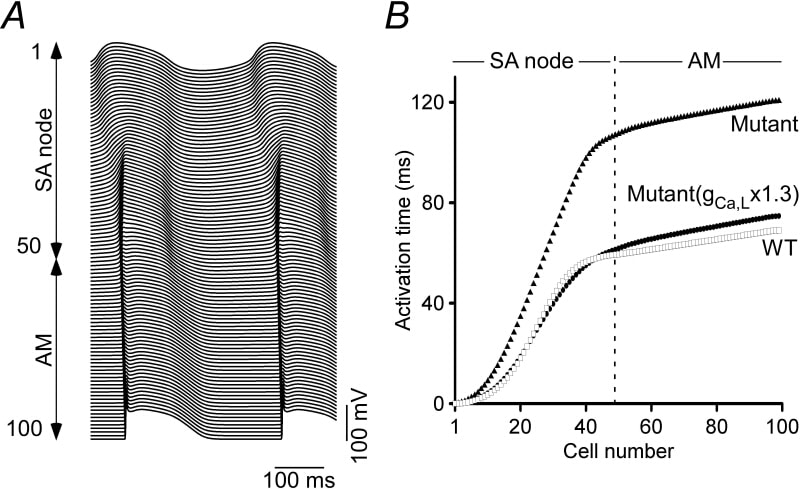In the heart, sodium ion channels play a major role in the initiation, propagation, and maintenance of normal cardiac rhythm. Sick sinus syndrome is an arrhythmia phenotype resulting from sinoatrial (SA) node dysfunction. Recently, it has been linked to mutations in the cardiac sodium channel gene, SCN5A (Benson et al. 2003). In this study, we investigated the functional effects of the mutations using computer simulation. We developed a one dimensional model of the SA node and neighbouring atrial muscle with wild-type (WT) or mutant SCN5A channels. The SA node and atrial muscle cells were simulated using the models of Zhang et al. (2000) and Ramirez et al. (2000), respectively. Figure 1A illustrates action potentials from all cells (50 SA node cells and 50 atrial cells) in the model under control conditions (WT channel) and the propagation of the action potential from the centre of the SA node to the atrial muscle is shown. Figure 1B illustrates the activation time of each cell (open squares). To simulate the effects of the mutations, the voltage dependence of inactivation of the sodium current (INa) was shifted by -10 mV, the time constant of inactivation of INa was increased three times, and the sodium conductance was decreased by up to 25%: when the sodium conductance was decreased by just 5% the conduction velocity in the SA node was decreased by 36% (Fig. 1B, filled squares); when the sodium conductance was decreased by 30% atrial stand-still occurred (data not shown). In a SCN5A+/- mouse, as well as a downregulation of SCN5A, there is an upregulation of L-type calcium channel genes (unpublished data). If this is translated into an increase in the L-type calcium current, it could be a compensatory mechanism, because Fig. 1B (circles) shows that a 30% increase in the L-type calcium channel conductance rescued sinoatrial conduction when the sodium conductance was decreased by 30%. These results suggest that the mutations in SCN5A may contribute significantly to SA node dysfunction.
University of Oxford (2004) J Physiol 561P, PC24
Communications: INSIGHTS INTO SICK SINUS SYNDROME CAUSED BY MUTATION OF THE CARDIAC SODIUM CHANNEL GENE
Inada,Shin ; Zhang,Henggui ; Honjo,Haruo ; Escande,Denis ; Boyett,Mark R;
1. University of Leeds, Leeds, United Kingdom. 2. University of Manchester, Manchester, United Kingdom. 3. Nagoya Univerity, Nagoya, Japan. 4. Faculte de Medicin, Nantes, France.
View other abstracts by:
Figure 1. Activation time of the 100 cells in the one dimensional model. AM atrial muscle.
Where applicable, experiments conform with Society ethical requirements.

